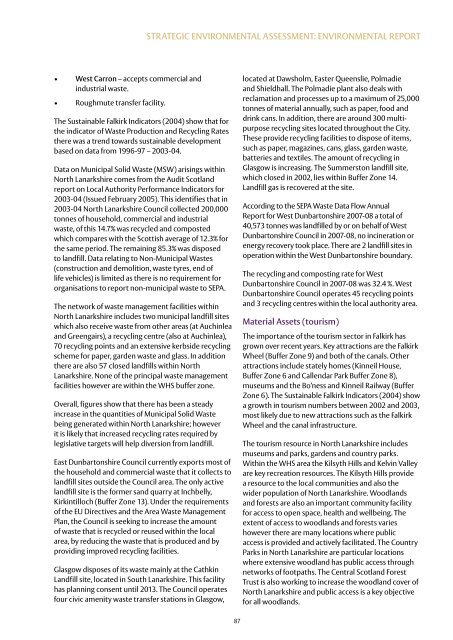The Antonine Wall Management Plan 2013-18 - Glasgow City Council
The Antonine Wall Management Plan 2013-18 - Glasgow City Council
The Antonine Wall Management Plan 2013-18 - Glasgow City Council
Create successful ePaper yourself
Turn your PDF publications into a flip-book with our unique Google optimized e-Paper software.
Strategic Environmental Assessment: Environmental Report<br />
• West Carron – accepts commercial and<br />
industrial waste.<br />
• Roughmute transfer facility.<br />
<strong>The</strong> Sustainable Falkirk Indicators (2004) show that for<br />
the indicator of Waste Production and Recycling Rates<br />
there was a trend towards sustainable development<br />
based on data from 1996-97 – 2003-04.<br />
Data on Municipal Solid Waste (MSW) arisings within<br />
North Lanarkshire comes from the Audit Scotland<br />
report on Local Authority Performance Indicators for<br />
2003-04 (Issued February 2005). This identifies that in<br />
2003-04 North Lanarkshire <strong>Council</strong> collected 200,000<br />
tonnes of household, commercial and industrial<br />
waste, of this 14.7% was recycled and composted<br />
which compares with the Scottish average of 12.3% for<br />
the same period. <strong>The</strong> remaining 85.3% was disposed<br />
to landfill. Data relating to Non-Municipal Wastes<br />
(construction and demolition, waste tyres, end of<br />
life vehicles) is limited as there is no requirement for<br />
organisations to report non-municipal waste to SEPA.<br />
<strong>The</strong> network of waste management facilities within<br />
North Lanarkshire includes two municipal landfill sites<br />
which also receive waste from other areas (at Auchinlea<br />
and Greengairs), a recycling centre (also at Auchinlea),<br />
70 recycling points and an extensive kerbside recycling<br />
scheme for paper, garden waste and glass. In addition<br />
there are also 57 closed landfills within North<br />
Lanarkshire. None of the principal waste management<br />
facilities however are within the WHS buffer zone.<br />
Overall, figures show that there has been a steady<br />
increase in the quantities of Municipal Solid Waste<br />
being generated within North Lanarkshire; however<br />
it is likely that increased recycling rates required by<br />
legislative targets will help diversion from landfill.<br />
East Dunbartonshire <strong>Council</strong> currently exports most of<br />
the household and commercial waste that it collects to<br />
landfill sites outside the <strong>Council</strong> area. <strong>The</strong> only active<br />
landfill site is the former sand quarry at Inchbelly,<br />
Kirkintilloch (Buffer Zone 13). Under the requirements<br />
of the EU Directives and the Area Waste <strong>Management</strong><br />
<strong>Plan</strong>, the <strong>Council</strong> is seeking to increase the amount<br />
of waste that is recycled or reused within the local<br />
area, by reducing the waste that is produced and by<br />
providing improved recycling facilities.<br />
<strong>Glasgow</strong> disposes of its waste mainly at the Cathkin<br />
Landfill site, located in South Lanarkshire. This facility<br />
has planning consent until <strong>2013</strong>. <strong>The</strong> <strong>Council</strong> operates<br />
four civic amenity waste transfer stations in <strong>Glasgow</strong>,<br />
located at Dawsholm, Easter Queenslie, Polmadie<br />
and Shieldhall. <strong>The</strong> Polmadie plant also deals with<br />
reclamation and processes up to a maximum of 25,000<br />
tonnes of material annually, such as paper, food and<br />
drink cans. In addition, there are around 300 multipurpose<br />
recycling sites located throughout the <strong>City</strong>.<br />
<strong>The</strong>se provide recycling facilities to dispose of items,<br />
such as paper, magazines, cans, glass, garden waste,<br />
batteries and textiles. <strong>The</strong> amount of recycling in<br />
<strong>Glasgow</strong> is increasing. <strong>The</strong> Summerston landfill site,<br />
which closed in 2002, lies within Buffer Zone 14.<br />
Landfill gas is recovered at the site.<br />
According to the SEPA Waste Data Flow Annual<br />
Report for West Dunbartonshire 2007-08 a total of<br />
40,573 tonnes was landfilled by or on behalf of West<br />
Dunbartonshire <strong>Council</strong> in 2007-08, no incineration or<br />
energy recovery took place. <strong>The</strong>re are 2 landfill sites in<br />
operation within the West Dunbartonshire boundary.<br />
<strong>The</strong> recycling and composting rate for West<br />
Dunbartonshire <strong>Council</strong> in 2007-08 was 32.4 %. West<br />
Dunbartonshire <strong>Council</strong> operates 45 recycling points<br />
and 3 recycling centres within the local authority area.<br />
Material Assets (tourism)<br />
<strong>The</strong> importance of the tourism sector in Falkirk has<br />
grown over recent years. Key attractions are the Falkirk<br />
Wheel (Buffer Zone 9) and both of the canals. Other<br />
attractions include stately homes (Kinneil House,<br />
Buffer Zone 6 and Callendar Park Buffer Zone 8),<br />
museums and the Bo’ness and Kinneil Railway (Buffer<br />
Zone 6). <strong>The</strong> Sustainable Falkirk Indicators (2004) show<br />
a growth in tourism numbers between 2002 and 2003,<br />
most likely due to new attractions such as the Falkirk<br />
Wheel and the canal infrastructure.<br />
<strong>The</strong> tourism resource in North Lanarkshire includes<br />
museums and parks, gardens and country parks.<br />
Within the WHS area the Kilsyth Hills and Kelvin Valley<br />
are key recreation resources. <strong>The</strong> Kilsyth Hills provide<br />
a resource to the local communities and also the<br />
wider population of North Lanarkshire. Woodlands<br />
and forests are also an important community facility<br />
for access to open space, health and wellbeing. <strong>The</strong><br />
extent of access to woodlands and forests varies<br />
however there are many locations where public<br />
access is provided and actively facilitated. <strong>The</strong> Country<br />
Parks in North Lanarkshire are particular locations<br />
where extensive woodland has public access through<br />
networks of footpaths. <strong>The</strong> Central Scotland Forest<br />
Trust is also working to increase the woodland cover of<br />
North Lanarkshire and public access is a key objective<br />
for all woodlands.<br />
87












![Elgin Cathedral Wedding Brochure [pdf, 544kb] - Historic Scotland](https://img.yumpu.com/22301571/1/190x151/elgin-cathedral-wedding-brochure-pdf-544kb-historic-scotland.jpg?quality=85)



